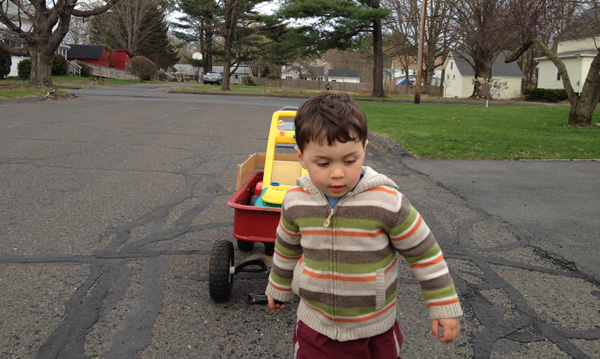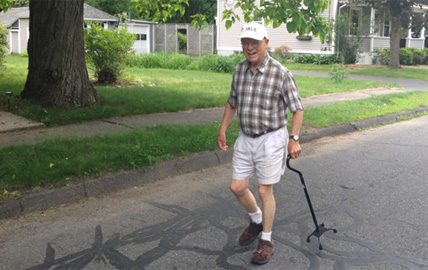By Dillon Sussman, Senior Planner, Pioneer Valley Planning Commission
One of the joys of being a land planner is that what I learn at work helps me understand how communities function and why people act the way they do. Here’s an example. A year ago I moved from one neighborhood to another in the same city. One of the first things that struck me was the difference in pedestrian behavior. In my old neighborhood, we walked on the sidewalk. In the new one, people usually walk in the street.
Overtime, I noticed some patterns. Single, middle aged people usually walk on the sidewalk. Parents with strollers walk on the edge of the street. Unaccompanied kids stick to the sidewalk. At 2:45 p.m., the street is overtaken by a loud, cussing, snow ball throwing, wrestling, running, biking horde of middle schoolers. They occupy the whole street—often causing cars to slow down or stop. Out of all of this, one older gentleman stuck out. Gene often wears a bright yellow coat, uses a cane, and walks slowly, but assuredly, in the middle of the street. He passes my house heading to the village center in the morning, and returns in the afternoon. Why, I wondered, does he walk in the middle of the road? Isn’t he afraid of the cars?

Photo courtesy of Dillon Sussman
So back to my work as a senior planner for the Pioneer Valley Planning Commission (PVPC). I recently completed updating the Massachusetts Healthy Community Design Toolkit to incorporate the needs of older adults. In our work we found that:
- The built environment of many communities does not meet the needs of older adults, and is likely contributing to negative health outcomes.
- Older adults are diverse and people age differently. Our communities need to be more diverse in order to accommodate the varying needs of older adults. This includes more diverse housing opportunities, more diverse access to goods and services, and more diverse transportation options.
- The needs of older adults are extremely personal and specific—they range from the macro scale, like a land use pattern that requires excessive driving or a lack of affordable housing, to the micro scale, like a difficult intersection.
- Older adults are a key leverage point for influencing change in our built environment. As active voters and citizens with a growing population, the opinions and actions of older adults will shape the public policies which in turn determine how our communities are design and built.
- Meeting the healthy community design needs of older adults will improve the built environment for all.
After reading a lot of literature on the topic, I developed a working theory about Gene’s walking behavior, which I later confirmed by talking with him. Gene, like many older people, wants to walk because he enjoys it and knows staying active is good for his health. In his late 80’s, he walks two and a half hours a day. It turns out the design of my neighborhood provides a pretty good environment for him to get out and walk.
First off, there is a village center near his house, where he can visit the library and a café. Second, the streets in the neighborhood are laid out in a grid pattern (as opposed to a series of cul-de-sacs off arterial roads). That means that Gene can take a relatively direct route from point A to point B without having to cross any excessively fast streets. Third, traffic volumes are relatively low in my neighborhood in part because of the grid pattern, which disperses traffic. All of this encourages Gene to walk. But still, why does he walk in the middle of the street?
The answer is simple: cracked sidewalks. Gene has weighed the risk of getting hit by a car versus the risk of tripping and falling on our cracked sidewalks. For him, cracks are a danger with every footstep, whereas cars provide only an occasional risk. Gene mitigates the risk of cars by wearing his yellow coat and walking in the middle of the road.
For him, it is common sense. For me, as a planner, it is a good lesson. On the one hand, I wish Gene didn’t have to make this kind of difficult calculation about risk to take a walk. I wish he had safe sidewalks, and I will work to make them available. I hope you will join me in that work in your community. On the other hand, I’m impressed with his spirit and I’m inspired by his commitment to maintaining his health by getting out and staying active.
To support the Genes in your neighborhood, please check out our recent update to the Massachusetts Community Design Toolkit. The Toolkit identifies the key steps we need to take to promote healthy community design for older people—and everyone else. It introduces the basics of zoning, subdivision regulations, street and sidewalk design, storm water, etc. It delves into specific community planning priorities for older adults including unique housing types, and road, sidewalk and parking lot design criteria. Checklists provide a snapshot of key reforms to advocate for at the local level. In short, the Toolkit is a crash course in land planning for people who want to know how to implement change on a local level.
Walking in the middle of the street was not one of our Toolkit recommendations. But maybe it should have been! The built environment matters, but so does the culture of a place. In my new neighborhood people walk in the street, and drivers have come to expect that. The horde of middle schoolers has taught us that pedestrians rule the street! And once you have seen that vision, you know you need drive slower. That helps everyone—from Gene with his yellow coat, to my two-year-old who sometimes pulls his red wagon down the middle of the road.
For more information, please contact Dillon Sussman at PVPC.
Download the toolkit

The author’s son pulling his wagon down the road (Photo courtesy of Dillon Sussman)

